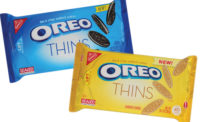For a culture focused on convenience and clean-label nutrition, bars continue to deliver. Sales of snack and granola bars on the whole have grown 2.9 percent during the 52 weeks ending October 7, 2018, according to data from IRI, Chicago, hitting a value of $6.2 billion.
“When consumers ate a snack or meal outside of the house in the past, more often than not, health and wellness weren’t much of a concern,” says Paul Verderber, vice president of sales, Carolina Innovative Food Ingredients, Nashville, NC. Today, though, consumers have begun to seek more nutrition at snack-oriented eating occasions. “The rapid growth of the nutrition bar category is evidence of this shift,” he says. “Bars are a great option for health-conscious consumers who are seeking a nutrient-dense snack to munch on between meals, or even in place of a meal.”
Bars with nutritional and intrinsic health value performed better than the category average, up 3.6 percent in sales to $3.2 billion. CLIF Bar far and away leads the segment, up 3.0 percent to $807.7 million. The breakfast, cereal and snack bar segment also saw notable growth, up 8.8 percent to $1.4 billion. Kellogg Co. leads the way in that segment, with growth of 3.6 percent to $631.4 million.
“Snacking is one of the fastest-growing categories globally as consumers look for foods that fit busy schedules and personalized diets, but also provide a nutritious boost,” says Harbinder Maan, associate director of trade marketing and stewardship, Almond Board of California, Modesto, CA. “Bars can pack a one-two punch with nutritious ingredients and bold flavors in a portable and controlled portion, great for hunger that hits at mid-morning and mid-afternoon, which are the most-popular times to snack.”
According to Bart Child, senior vice president of commercial development, Nellson, LLC, Anaheim, CA, health attributes and portion control are just part of the reason why bars experience ongoing success. “The demand for nutritional snacking has contributed to the proliferation of nutritious products in non-traditional channels, like mainstream retailers and c-stores.”
Healthy ingredients
When it comes to bars, low-fat plant protein is in high demand, notes Gilles Maller, vice president, sales and international, Clextral, Tampa, FL. “Consumers are reading the ingredient label and looking for specific ingredients they believe to have health benefits, rather than just grabbing a ‘protein bar’ and assuming it is a healthy choice.”
Whey and soy used to dominate bar labels, but today’s sources are more diversified. “Plant proteins like pea, beans and lentils are gaining traction,” says Pam Stauffer, global marketing programs manager, Cargill, Minneapolis. “These newer proteins fit many of today’s biggest product development trends: non-GMO, organic, sustainable, vegan, gluten-free, soy-free, label-friendly and more.” They’re also easier than ever for brands to use, with fewer challenges. Cargill’s PURIS pea protein comes from a proprietary pea seed variety that’s specially selected to minimize the off-flavors normally attributed to pulses.
Whole-food protein sources are also making waves in the bars market. Almonds, for example, have always been seen as a nutritional, high-protein, plant-based ingredient, says Jeff Smith, director of marketing, Blue Diamond Almonds Global Ingredients Division, Sacramento, CA. “Leveraging that superfood potential in a powder allows bar manufacturers even more versatility.” He notes that the protein powder has a subtle, clean flavor profile, and an extra-fine texture.
Child notes that nut selection for bars is expanding, now including cashews, walnuts, pistachios, pecans, hazelnuts, and macadamia nuts. These ingredients also fit well within decadent flavor trends, lending themselves well to options like cashew cookie or caramel nut brownie.
High in good fats, nuts also appeal to consumers adhering to the ketogenic diet, which encourages low carbohydrates and high dietary fats. “Among the most sought-after ingredients that meet this need, whole or ground nuts stand out as champions, because they not only provide fats viewed as healthy (monounsaturated and polyunsaturated fats), but most also contribute non-negligible amounts of protein and some fiber,” says Child.
Nut butters are also trending in bars. Almond butter, for example, brings nutrition, texture and flavor to satiate consumers, notes Maan. “We’re now seeing it used as a binder, filling and even a topping to bring a premium feeling to snacking.”
Other health-forward ingredients on the radar include grains like quinoa, amaranth and sorghum, says Don Trouba, senior director, go-to-market, The Annex, Ardent Mills, Denver. “Grains bring a lot of texture like chewiness, and some pops of crispness and crunch.” The company offers Blackjack Barley flakes for bars and other snacks, as well as Great Plains Quinoa Crisps, both providing ancient grain appeal.
“Consumers flock to unique ingredients, especially if they have strong nutritive benefits,” says Verderber. “Consumers know and love sweet potatoes, and our sweet potato ingredients offer a strong nutritional profile, including high levels of vitamin A, beta-carotene, potassium and calcium.” Selections from the Carolina Craft line of dehydrated sweet potato ingredients, from sweet potato flour to sweeteners, work well in bar formulations.
Flavors forward
Dessert-inspired flavors still resonate with the bar consumer, says Child, citing examples like tiramisu and banana nut bread. This trend is especially prevalent in high-protein sports nutrition bars, he says, as “athletes and regular exercisers who consume bars on a daily basis might seek out more variety, as well as a reward for their workout.” Bakery-inspired flavors also resonate with the weight-loss consumer, he adds, as “bars aimed at diet or weight loss, as well, are veering toward the decadent, encouraging their consumers to pursue indulgence in a more-permissible manner than a trip to the bakery aisle.” McKee Foods, for example, recently launched a new Carrot Cake variety of its Sunbelt granola bars.
“Some manufacturers are leaning into irresistible dessert and bakery flavors to jump out at shelf, such as cookies and cream, chocolate chip cookie dough, brownie, and more,” says Gretchen Hadden, marketing communications manager, Cargill Cocoa & Chocolate. “On the reverse side, dark chocolate, with its high cacao content, is being paired with nuts, fruits, and superfoods to strike the perfect balance of great taste with a healthy halo.”
Derek Timm, technical sales director, Taiyo, Minneapolis, says sweet and salty, as well as sweet and spicy, help drive the bars market. “Consumers have curious palates and always want to try something new.” Seasonal flavors like pumpkin for Halloween or cranberry for Thanksgiving are also resonating, because people like their foods to reflect seasonal trends, he adds. For example, Health Warrior recently launched two new flavors of its Organic Pumpkin Seed Bars in time for the holidays: Dark Chocolate Coconut Almond and Maple Sea Salt.
Taiyo recently developed SunCran Naturelle, which contains its Sunfiber, a prebiotic fiber, as well as Fruit d’Or’s organic cranberry juice powder. “This product hits many consumer trends, including providing prebiotic dietary fiber, organic seasonal flavor, no added sugar, and non-GMO,” Timm says. The ingredient is also certified low-FODMAP.
Looking ahead, better-for-you bars will only continue to get better, Timm says. “I believe the bar format represents an opportunity to incorporate more nutraceutical ingredients … we can provide ingredients that confer a benefit to the end consumer.”





